#Amphiprion perideraion
Photo
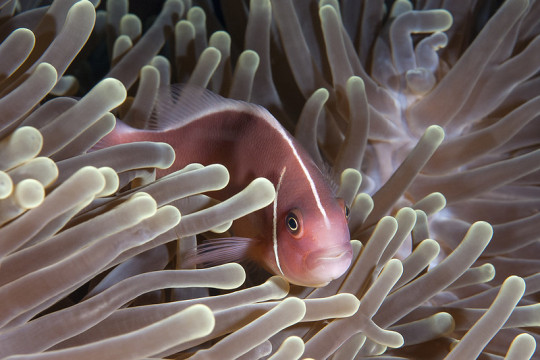
A pink skunk clownfish (Amphiprion perideraion) hides in the nematocysts of an anemone in the Andaman Sea, Thailand
by Pierrette Wagner
#pink skunk clownfish#clownfish#bony fish#fish#Amphiprion perideraion#amphiprion#pomacentridae#actinopterygii#chordata#wildlife: thailand
300 notes
·
View notes
Text

Pink anemonefish (Amphiprion perideraion) in closed anemone -
Photo by Juergen Freund
#Amphiprion perideraion#Amphiprion#anemonefish#pink anemonefish#fish#anemone#orange#orange anemone#sea anemone#ocean#sea#marine#marine life#marine animals#wildlife#animals#nature
18 notes
·
View notes
Text
Creature Awaits #243
Each week I plan to feature an amazing creature, admiring God's fantastic artistry. Hopefully it’ll brighten someone’s day to see something new and interesting if they haven’t seen it before. : )
As the Pantone color of the year is "Peach Fuzz", so we'll dive into the second month of this relatively new year by featuring creatures of this cozy, comforting color. : )

(Gorgeous still taken by talented photographer, Christian Gloor (CC BY 2.0 Deed))
The Pink Skunk Clownfish
A.K.A: The Pink Anemonefish
(Yes, despite the name, it's actually more peach in hue. : ) )
Scientific Name: Amphiprion perideraion
Region: Reef lagoons and slopes across the western Pacific and eastern Indian oceans
Size: Up to about 3.9" (~10cm)
Interesting Notes: Unlike many anemonefish species, the Pink Skunk Clownfish, one of the smallest anemonefish, is willing to share its anemone host home with another species. : )
#creatureawaits#beautiful animals#beautiful fish#peach fuzz#Pink Skunk Clownfish#cute animals#Pink Anemonefish#Amphiprion perideraion
1 note
·
View note
Text
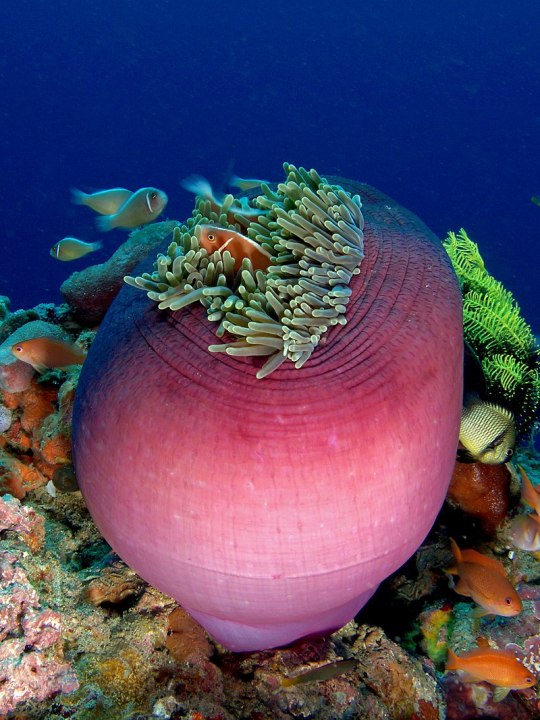
Magnificent Anemone (Heteractis magnifica), family Stichodactylidae, East Timor
with Pink Anemonefish (Amphiprion perideraion), family Pomacentridae
photograph by Nick Hobgood
#anemone#cnidaria#animals#nature#ocean#heteractis#stichodactylidae#asia#fish#anemonefish#amphiprion#ichthyology#pomacentridae
433 notes
·
View notes
Text

Heteractis magnifica Amphiprion perideraion
120 notes
·
View notes
Photo

Pink anemonefish (Amphiprion perideraion) in Magnificent sea anemone (Heteractis magnifica), on a coral reef in the Indian Ocean
photograph by Nick Hobgood | Wikipedia CC
#anomone#clownfish#anemonefish#fish#symbiosis#nature#ocean#animals#marine biology#cnidaria#coral reef
59 notes
·
View notes
Text
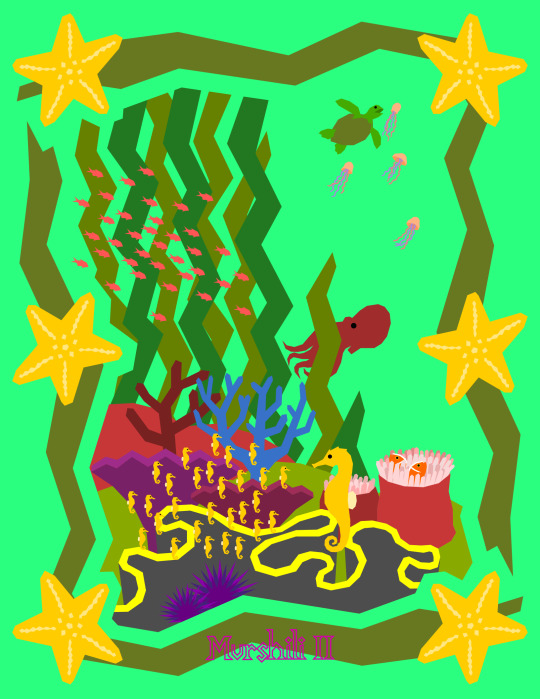
Father’s Day special: Under the Waves
~ ~
Our twentieth Spring Vignettes piece celebrates Father’s Day, which is on June 18th.
Before you read what the piece was intended to portray, share what it portrays to _you_. I’m just the artist; you’re the beholder.
Leave a comment.
~ ~
For those of you whose ichthyology is rusty, seahorses are known for a very unusual quirk of their reproductive biology: When mating, the female lays eggs into a specialized gestation-chamber in the male’s abdomen; and the male then carries the eggs to term inside his own body. When the eggs hatch, the male gives birth, and the itty bitty fully-formed seahorses are born into the water.
This makes seahorses a very rare example of male pregnancy in the animal kingdom, found only in seahorses and their close relatives. Why this reproductive strategy is advantageous for seahorses, and not for other fish, is debated by marine biologists.
Fatherhood, at large, is a relatively rare concept in nature; among mammals, paternal care is the exception, not the rule; but it is surprisingly common among fish. The reasons for this are debated.
Seahorses are found in coral reefs, kelp forests, and estuaries, where they can use their little prehensile tails to hold onto things. Coral reef seahorses include the yellow tigertail seahorse (Hippocampus comes), which is found in tropical coral reefs of the Indo-Pacific region. These are extremely biodiverse habitats, home to a great diversity of species.
Cnidarians are well-represented in this scene. The tiny colonial filter-feeders that build coral reefs over millennia are cnidarians; including those that form the foliate “lettuce leaf” coral in the near foreground, and the staghorn corals in the far foreground.
As for the undulated flaring fan-shaped corals in the mid-foreground, I’m afraid I may have accidentally made them up. I thought there was a coral that looked like this; but I can’t seem to find one. I may have been inspired by the flower Celosia argentea var. cristata, one cultivar of which is appropriately called “Coral Reef Celosia”. Due to its fasciation or “cresting”, this variant does have this undulated fanning shape, reminiscent of some elkhorn corals.
In the right foreground, we see several sea anemones, another cnidarian. These are probably magnificent sea anemones (Heteractis magnifica). Among the tentacles of one sea anemone, there are two pink skunk clownfish (Amphiprion perideraion). Like other anemonefish, they are symbiotic with sea anemones; living inside them for protection, without being stung, and in return cleaning the anemone of parasites, providing nitrogen, and even helping the anemone breathe and feed by moving water through it.
Anemonefish are protandrous hermaphrodites, spending the first period of their lives as males, and becoming females later in life. They live in groups consisting of a single female and a number of males, with only the largest male permitted to breed. If the female is lost, one of the largest males will become female to take her place, and the next-largest male will become the new breeding male.
A third cnidarian is found in the upper right background; several jellyfish, possibly Indonesian sea nettles (Chrysaora chinensis), about to be munched by a green sea turtle (Chelonia mydas). Young green sea turtles eat a great quantity of jellyfish and other prey, whereas older green sea turtles eat various algae and aquatic plants. Due to the inward-pointing spines in their throats, green sea turtles never fail to eat their prey; but unfortunately, this also prevents them from spitting out plastic bags, which also look exactly like jellyfish.
The large school of swallow-tailed fish swimming among the kelp consists of anthias, possibly princess anthias (Pseudanthias smithvanizi). In contrast to anemonefish, anthias are protogynous hermaphrodites, spending the first period of their lives as females, and becoming males later in life. Even when they school together in large numbers, they divide themselves into small groups (or “harems”) consisting of one dominant male, several subdominant males, and a number of females. If the dominant male is lost, the subdominant males and the largest females will compete to become the next dominant male.
Behind the kelp, there is a giant pacific octopus (Enteroctopus dofleini). They grow to be the largest octopuses, and possibly the most intelligent of all invertebrates. Female octopuses breed only once in their lives; after laying a clutch of eggs, they vigilantly guard them, clean them, and circulate water over them, not leaving them unattended even to eat; and around the time the eggs hatch, they usually die of starvation. It is extremely unusual for a solitary animal to be highly intelligent; almost all highly intelligent animals are social; but octopuses are the one curious exception. If they had the opportunity to learn from their parents, they would be unstoppable.
Finally, in the lower left foreground, there can be seen two purple sea urchins (most likely Echinostrephus molaris). These are echinoderms, related to starfish, such as those seen in the frame. Echinoderms are notable for having bilateral symmetry as larvae, like fish and humans, but having radial symmetry as adults, like jellyfish and sea anemones. When they metamorphose, their left-hand side grows into their radially symmetrical adult body, and their right-hand side disappears.
The frame is formed out of starfish and kelp. Kelp may appear very plant-like, but it is actually a giant multicellular brown alga; not closely related to green algae or their land-dwelling plant relatives.
Parenthood certainly varies greatly from species to species. Life is unbelievably varied in every way imaginable.
#fathers_day#father#seahorse#fish#ocean#sea#underwater#marine#coral_reef#kelp#spring#springholidays#digitalart#vector#mosaic#collage#inkscape
1 note
·
View note
Photo
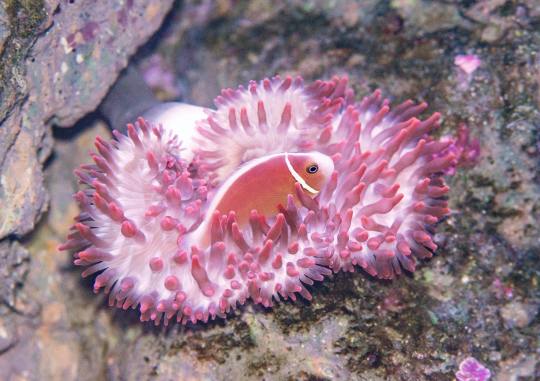
Pink Anemonefish
242 notes
·
View notes
Video
Pink Skunk Clownfish | Amphiprion perideraion
#Pink Skunk Clownfish#Pink Skunk Anemonefish#Amphiprion perideraion#saltwater#ocean#sea#marine#underwater#undersea#nature#aquatic#aquaria#aquablr#aquarium#Anemonefishes#marine biology#marine biodiversity#biodiversity#scuba diving#coral reef#coral#reef#anemone
60 notes
·
View notes
Photo
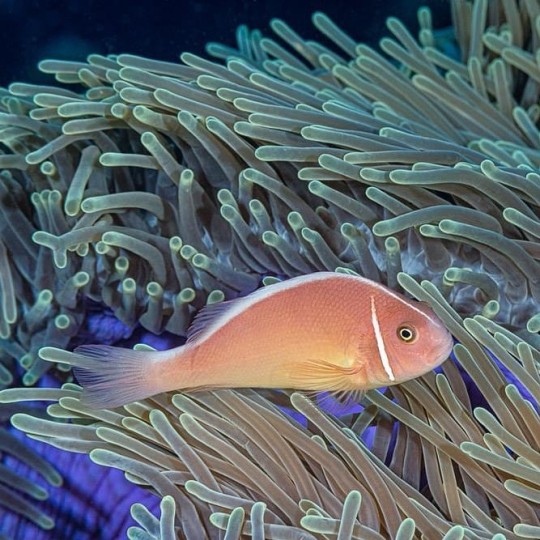
Did you know? There are nearly 30 species of clownfish! Here’s one you may not know: the pink skunk clownfish (Amphiprion perideraion). Also known as the pink anemonefish, it can be found in parts of the Indo-Pacific where, like other clownfish species, it has an affinity for anemones. The anemone's poisonous tentacles offer protection to the clownfish, which takes refuge from predators (and is itself protected from its host's stings thanks to a layer of mucus). In turn, the fish aggressively defends its host from other fish and cleans off parasites. Photo: François Libert, CC BY-NC-SA 2.0, flickr #AnimalFacts #clownfish #anemone #OceanLife #nature https://www.instagram.com/p/CbLyuvcLlHD/?utm_medium=tumblr
254 notes
·
View notes
Text
Animal Crossing Fish - Explained #169
Brought to you by a marine biologist who thanks all of you for reading...
CLICK HERE FOR THE AC FISH EXPLAINED MASTERPOST!
It’s always a treat to see someone stumble across one of the Fish Explained posts and then subsequently read and like or reblog a hug chunk of it. I’ve come on Tumblr to see I’ve gotten 60 messages or something and it’s literally one person. I love all of you who have done that and all those in the future who will inevitably do it. I’m so glad you love learning!
And because we just covered the Black Clownfish the other day, I figure today is as good a time as any to cover another type of clown fish - the pink anemone fish!

This pretty little fish appeared in Animal Crossing Pocket Camp for their Sakura Class, Fishing Tourney #37 in April of 2021. Who knows if it will come back this year.
This is another little friend from Genus Amphiprion, the anemone fish, just like the Ocellaris Clownfish. It’s more common name is the Pink Skunk Clownfish (Amphiprion perideraion), named after its pink color and the white stripe running down its back. It is part of the skunk anemone fish complex, which includes other very similar species. The Pink Skunk is particularly widespread, ranging from The Great Barrier Reef off Australia, north to some of Japans southern islands. It is most associated with coral reefs, settling into four specific kinds of anemones, one of them being the Magnificent Sea Anemone, the same species that appears in Animal Crossing New Horizons.
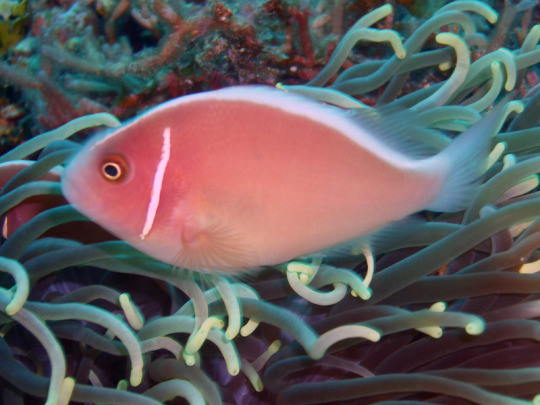
Pic: Samuel Chow on Wikimedia commons.
Have I ever really explained how anemone fish actually create their mutualistic relationship with the anemone of their choice? Because, though the anemone benefits from this relationship, a lot of the work is one-sided on the fish. See, anemones are close cousins of jellies, so they have those stinging cells in their tentacles, which helps them to catch prey. In order to live within theses stinging tentacles, the anemone fish have a thick mucus covering their bodies that protects them. It’s not that anemone fish don’t get stung, it’s that they just don’t care.
And there you have it. Fascinating stuff, no?
#anemonefish#clownfish#fish#animal crossing#animal crossing pocket camp#animals#marine biology#pink anemonefish#pink skunk clownfish#science in video games#animal crossing fish explained
8 notes
·
View notes
Video
katevylet
Peekaboo, who are you?! This pink skunk clownfish (Amphiprion perideraion) was very skeptical of her alien visitor. Luckily for her, she lives in a stinging fortress that keeps her safe from predators and cameras.
Coming from California where our anemones typically only span a few inches across, seeing these tropical behemoths was quite the shock. It's a good thing we don't have anemonefish here because they'd definitely be downgrading from mansions to studio apartments.
#clownfish#animal#wildlife#sea anemone#video#underwater#fiji#coral#reef#dive#instagram#the earth story
169 notes
·
View notes
Photo

Pink anemonefish by alanbessette Pink skunk clownfish or pink anemonefish (Amphiprion perideraion) ピンククマノミ
18 notes
·
View notes
Text
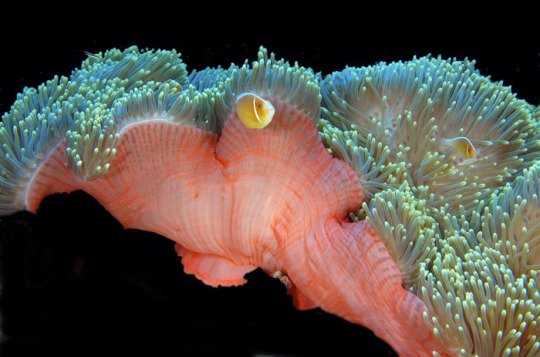
Heteractis magnifica & Amphiprion perideraion
# Heteractis magnifica# Amphiprion perideraion #photography#upl#nature#fish#anemone#sea#sea anemone#marine life#seascape
6 notes
·
View notes
Video
Мадагаскар. Риф рядом с Мангили. Розовый амфиприон / Amphiprion perideraion прячется в щупальцах Актинии / Heteractis magnifica, с которой образует симбиотические отношения. (at Toliary, Toliara, Madagascar) https://www.instagram.com/p/B5683g7nQSX/?igshid=1iqlhn3z9hdyb
0 notes
